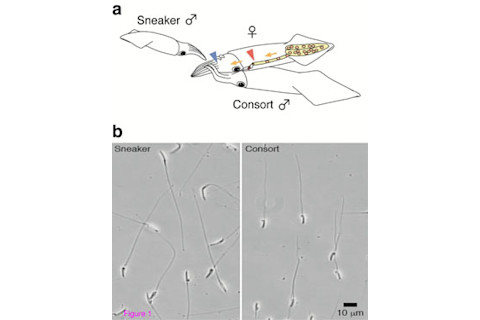
What’s the News: In the squid world, the body size of male spear squid determines the mating strategies they use. Small male squid, which have no chance of physically competing with their larger rivals, must try to get with the females of the species on the sly. Now, researchers in Tokyo have learned that this difference in mating behavior has resulted in the evolution of divergent sperm types, though perhaps not in the way you’d think: diminutive male squid actually produce larger sperm than big male squid
. What’s the Context:
Male spear squid, also known as Bleeker’s squid, are either large “consorts,” or small “sneakers.” During mating, consorts will try to court a female by flashing vibrant colors across their bodies; if successful, a consort will place a packet of sperm, called a spermatophore, into the female’s oviduct, a tube that leads to her ovaries. As you’d expect from his title, the consort male will then guard his mate and try to keep other males away while the female lays her eggs.
Sneaker males are also true to their name. Rather than courting, a sneaker waits for a female to begin laying her eggs, at which point he rushes in head first and deposits his spermatophore near her external sperm storage organ (just under her mouth). When timed well, the released eggs will pass over the sneaker’s sperm and possibly become fertilized, if the eggs haven’t already been fertilized by the consort’s sperm inside the female’s oviduct.
The males are specialized for only one mating strategy and transitioning from consort to sneaker (or vice versa) is unlikely. As the authors point out in their study (pdf) published in the journal BMC Evolutionary Biology, “it is not known to what extent either genetic or environmental factors determine male morphology or mating tactic.”
How the Heck:
The researchers began by collecting and measuring the sperm size of consort and sneaker male squids. They found that the average size of both the head and flagellum of consort male sperm were smaller than those of sneaker males—in total, consort male sperm were about 73 micrometers, compared to the sneaker males’ 99 micrometers. This is the first time scientists have found sperm differences in dimorphic males.
The team then decided to take a look at the fertility of the different sperm, and found that both types were able to fertilize squid eggs in vitro. Moreover, the researchers found no difference in sperm mobility between the males (though, surprisingly, they did see that the spermatophores of consorts contained more sperm cells than those of sneakers).
The researchers believe that the sneaker squid's sperm may be adapted to work better for their particular fertilization technique; the bigger sperm may work better in seawater than the smaller sperm of the consorts.
[via Livescience
]
Image courtesy of Y. Iwata et al /













